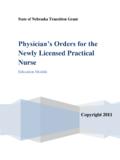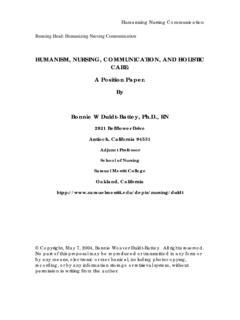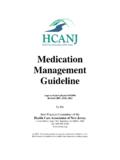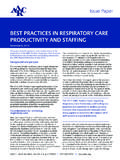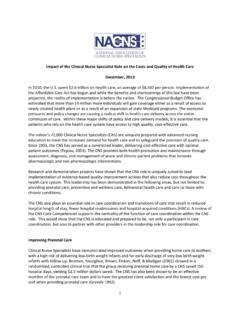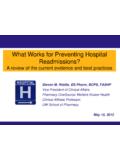Transcription of Physician’s Orders for the - Nebraska Center for Nursing
1 State of Nebraska Transition Grant physician 's Orders for the New Graduate Registered Nurse Education Module Copyright 2011. Title: physician 's Orders Learning Objectives: Upon completion of this education module, the new graduate registered nurse will: Discuss the formal and informal processes of communication with primary care providers. Describe the process used to obtain Orders for admission and discharge of a client and to complete medication reconciliation upon admission and discharge. Anticipate Orders that may be needed as a result of communicating a change in client status to a health care provider: emergent and non-emergent.
2 Recognize and use communication tools specific to the clinical facility. Describe the types of Orders used in health facilities. Review facility-specific and unit-specific policies related to when provider's Orders are needed use of restraints, etc. Review agency- and/or unit-specific pre-printed physician 's Orders and when these are used pre-procedure, pre-operative, induction of labor, etc. Review appropriate abbreviations, symbols, acronyms and dose designations for use in health care facilities. Interactive Exercises: Use of an SBAR communication tool. See Appendix A. Review SBAR Communication, Guidelines for Communicating with Physicians Using SBAR.
3 And the SBAR tools. Determine what communication tool(s) is used by the employer. With the preceptor, discuss how it is used. Compare and contrast this tool with the SBAR communication tools. All newly licensed nurses are to complete scenario # 1 and 2 and one additional scenario of choice, using an appropriate SBAR tool from the facility, or in Appendix A. Review written SBAR communication tools with the preceptor. Discuss scenario responses with the preceptor and compare and contrast how the preceptor would have responded. If in a group of newly hired nurses, discuss responses with other group members. Compare and contrast individual responses with those of the other group members.
4 Discuss situations when SBAR is not effective. Preceptor, in the role of the provider does a role play with the nurse in the following situations: provider is not cooperative in using the SBAR. format and terminates the call abruptly before responding to the nurse's concern; provider will not agree to any of the nurse's recommendations and gets upset. 1) Discuss how the nurse felt in this role play, how she handled the discussion, what could have been done differently. If in a group of newly hired nurses, discuss observations of other group members. 2. 2) Preceptor and other nurses from the unit/facility discuss their personal experiences in the use of SBAR and difficulties with the communication process with providers.
5 Locate phone numbers of providers affiliated with facility or unit. a) Are there differences in how communication occurs among individual providers, groups of providers, and on weekdays versus the night shift and weekends? b) Identify the telephone chain of communication used by the facility a secretary/paging system receives calls and forwards them to the unit, providers call nurses directly, a charge nurse calls all providers, etc. c) Discuss the pros and cons of this communication system with the preceptor. Locate and review a list of accepted common abbreviations or terms used in the facility or unit ER (emergency room), BMP (basic metabolic panel), 0 2 sat (pulse oximetry), etc.
6 A) Are these within the accepted guidelines of the ISMP and Joint Commission? (See Appendix D). b) Discuss this list with the preceptor: its location, how often it is revised/updated, what is acceptable and unacceptable according to hospital protocol, differences between units, variations within the facility. c) Complete an audit of a chart or electronic health record reviewing all abbreviations used and clarify which are official and unofficial. This section (# 4) is to be completed by the newly licensed nurse working in long-term care or assisted living using the protocol for change of condition for communication in a long-term care or assisted living community.
7 See Appendix. a) Review this communication tool. b) Complete the 3 scenarios. c) Review responses to scenarios with the preceptor. Discuss individual responses and compare and contrast how preceptor would have responded. If in a group of newly hired graduate nurses, discuss individual responses with other group members. Compare and contrast individual responses with those of the other group members. Review the physician 's order sheets used in the facility. If standard order sets are used, obtain a copy to review. a) Review the facility policy/procedure on obtaining and completing provider's Orders ; how the Orders are taken off and initiated; how to check on the status of an order in process; when Orders are to be called to provider ( renewal, discontinuation, etc.
8 B) Discuss this policy and these procedures with the preceptor. c) Review pre-printed Orders (pre-op, pre-procedure, Code Blue, etc.), what information the nurse is expected to obtain, complete and/or insert. d) Preceptor and nurse participate in taking Orders off a chart or electronic health record and initiating these Orders , check on the status of an order , discuss how an order is handled if needed, and any follow-up needed with provider, ancillary departments or other members of the health care team. Role play obtaining physician 's Orders for the admission of one client and the discharge of another client with the preceptor in the role of the provider; complete the medication reconciliation process; complete prescriptions to be given to the client being discharged.
9 3. a) Select a newly admitted client and another who is being discharged. Review these clients' health records. b) Using client information and SBAR communication tools, contact the provider (preceptor) to obtain admission and discharge Orders , complete medication reconciliation and prescriptions for home use. c) Use a blank physician 's order sheet to write these Orders . If the facility uses standard order sets for admission and discharge, obtain a copy of order sets and use them in this role play activity; use other related forms. Review the Check-Back or Read-Back Communication Strategy. See Appendix C. a) With the preceptor, review how this strategy is implemented in the facility.
10 B) Using provider's Orders on select client health records, identify where and how this is documented. Appendix D reading and writing provider's Orders . For these scenarios, the following documents are to be reviewed: a) Joint Commission's Official Do Not Use List . b) ISMP's List of Error-Prone Abbreviations, Symbols and Dose Designations Appendix E Types of Orders in Facilities. a) Select health care records of 2-3 clients on the unit and review the provider's Orders . Identify the types of written Orders , order sets or pre-printed Orders . b) With the preceptor, review the facility policy on: 1) when a verbal or telephone order can be taken and not taken; exceptions to this policy 2) who can write Orders within the agency ( resident physicians, consulting physicians, non-affiliated physicians, nurse practitioners, etc.



